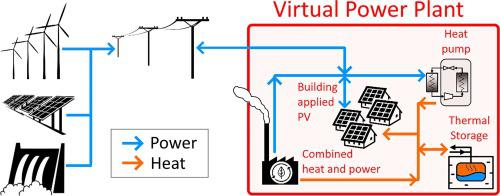当前位置:
X-MOL 学术
›
Energy Convers. Manag.
›
论文详情
Our official English website, www.x-mol.net, welcomes your
feedback! (Note: you will need to create a separate account there.)
A residential community-level virtual power plant to balance variable renewable power generation in Sweden
Energy Conversion and Management ( IF 9.9 ) Pub Date : 2021-01-01 , DOI: 10.1016/j.enconman.2020.113597 Svante Monie , Annica M. Nilsson , Joakim Widén , Magnus Åberg
Energy Conversion and Management ( IF 9.9 ) Pub Date : 2021-01-01 , DOI: 10.1016/j.enconman.2020.113597 Svante Monie , Annica M. Nilsson , Joakim Widén , Magnus Åberg

|
Abstract Power systems with large shares of variable renewable electricity generation, i.e., wind and solar power, require high flexibility in both power generation and demand. Heat pumps and combined heat and power units within district heating systems, and thermal storages have previously been studied for their potential to increase the flexibility of the energy system. When using these technologies for power balancing, they must be operated in a non-standard way with switched merit-order. This study hypothesizes that a residential area could form a local operated entity, i.e., a virtual power plant, that provides power-balancing services to a national power system. The hypothesis is tested with a case-study in Sweden where a combined heat and power unit, heat pumps, a local heat distribution system, and a thermal storage constitute the local entity. A simulation of the energy balances in the system, with optimization of storage size, was performed. The results show that all power surpluses in the system are consumed by the heat pumps. 43% of the annual and 21% of the electricity peak load are covered by the combined heat and power unit. It is concluded that an inter-seasonal thermal storage is crucial for the system's flexibility. Also, large electricity surpluses, if converted to heat and stored, limit the ability of the virtual power plant to utilize the combined heat and power unit for power balancing at a later stage. Despite this, a local virtual power plant can provide increased flexibility by offering power-balancing services to the power system.
中文翻译:

平衡瑞典可变可再生能源发电的住宅社区级虚拟发电厂
摘要 风能和太阳能等可变可再生能源发电占比较大的电力系统,在发电和需求方面都需要高度的灵活性。区域供热系统中的热泵和热电联产装置以及蓄热装置以前曾被研究过,因为它们具有提高能源系统灵活性的潜力。当使用这些技术进行功率平衡时,它们必须以非标准的方式运行,并具有切换的优先顺序。本研究假设住宅区可以形成一个本地运营实体,即虚拟发电厂,为国家电力系统提供电力平衡服务。该假设在瑞典的案例研究中得到检验,其中热电联产机组、热泵、局部热分配系统、和一个蓄热体构成局部实体。对系统中的能量平衡进行了模拟,并优化了存储大小。结果表明,系统中的所有剩余功率都被热泵消耗了。热电联产机组覆盖全年43%和21%的用电高峰负荷。得出的结论是,季节性储热对于系统的灵活性至关重要。此外,如果将大量剩余电力转化为热能并储存起来,则会限制虚拟发电厂在后期利用热电联产装置进行电力平衡的能力。尽管如此,本地虚拟发电厂可以通过向电力系统提供电力平衡服务来提供更高的灵活性。与存储大小的优化,执行。结果表明,系统中的所有剩余功率都被热泵消耗了。热电联产机组覆盖全年43%和21%的用电高峰负荷。得出的结论是,季节性储热对于系统的灵活性至关重要。此外,如果将大量剩余电力转化为热能并储存起来,则会限制虚拟发电厂在后期利用热电联产装置进行电力平衡的能力。尽管如此,本地虚拟发电厂可以通过向电力系统提供电力平衡服务来提供更高的灵活性。与存储大小的优化,执行。结果表明,系统中的所有剩余功率都被热泵消耗了。热电联产机组覆盖全年43%和21%的用电高峰负荷。得出的结论是,季节性储热对于系统的灵活性至关重要。此外,如果将大量剩余电力转化为热能并储存起来,则会限制虚拟发电厂在后期利用热电联产装置进行电力平衡的能力。尽管如此,本地虚拟发电厂可以通过向电力系统提供电力平衡服务来提供更高的灵活性。热电联产机组覆盖全年43%和21%的用电高峰负荷。得出的结论是,季节性储热对于系统的灵活性至关重要。此外,如果将大量剩余电力转化为热能并储存起来,则会限制虚拟发电厂在后期利用热电联产装置进行电力平衡的能力。尽管如此,本地虚拟发电厂可以通过向电力系统提供电力平衡服务来提供更高的灵活性。热电联产机组覆盖全年43%和21%的用电高峰负荷。得出的结论是,季节性储热对于系统的灵活性至关重要。此外,如果将大量剩余电力转化为热能并储存起来,则会限制虚拟发电厂在后期利用热电联产装置进行电力平衡的能力。尽管如此,本地虚拟发电厂可以通过向电力系统提供电力平衡服务来提供更高的灵活性。
更新日期:2021-01-01
中文翻译:

平衡瑞典可变可再生能源发电的住宅社区级虚拟发电厂
摘要 风能和太阳能等可变可再生能源发电占比较大的电力系统,在发电和需求方面都需要高度的灵活性。区域供热系统中的热泵和热电联产装置以及蓄热装置以前曾被研究过,因为它们具有提高能源系统灵活性的潜力。当使用这些技术进行功率平衡时,它们必须以非标准的方式运行,并具有切换的优先顺序。本研究假设住宅区可以形成一个本地运营实体,即虚拟发电厂,为国家电力系统提供电力平衡服务。该假设在瑞典的案例研究中得到检验,其中热电联产机组、热泵、局部热分配系统、和一个蓄热体构成局部实体。对系统中的能量平衡进行了模拟,并优化了存储大小。结果表明,系统中的所有剩余功率都被热泵消耗了。热电联产机组覆盖全年43%和21%的用电高峰负荷。得出的结论是,季节性储热对于系统的灵活性至关重要。此外,如果将大量剩余电力转化为热能并储存起来,则会限制虚拟发电厂在后期利用热电联产装置进行电力平衡的能力。尽管如此,本地虚拟发电厂可以通过向电力系统提供电力平衡服务来提供更高的灵活性。与存储大小的优化,执行。结果表明,系统中的所有剩余功率都被热泵消耗了。热电联产机组覆盖全年43%和21%的用电高峰负荷。得出的结论是,季节性储热对于系统的灵活性至关重要。此外,如果将大量剩余电力转化为热能并储存起来,则会限制虚拟发电厂在后期利用热电联产装置进行电力平衡的能力。尽管如此,本地虚拟发电厂可以通过向电力系统提供电力平衡服务来提供更高的灵活性。与存储大小的优化,执行。结果表明,系统中的所有剩余功率都被热泵消耗了。热电联产机组覆盖全年43%和21%的用电高峰负荷。得出的结论是,季节性储热对于系统的灵活性至关重要。此外,如果将大量剩余电力转化为热能并储存起来,则会限制虚拟发电厂在后期利用热电联产装置进行电力平衡的能力。尽管如此,本地虚拟发电厂可以通过向电力系统提供电力平衡服务来提供更高的灵活性。热电联产机组覆盖全年43%和21%的用电高峰负荷。得出的结论是,季节性储热对于系统的灵活性至关重要。此外,如果将大量剩余电力转化为热能并储存起来,则会限制虚拟发电厂在后期利用热电联产装置进行电力平衡的能力。尽管如此,本地虚拟发电厂可以通过向电力系统提供电力平衡服务来提供更高的灵活性。热电联产机组覆盖全年43%和21%的用电高峰负荷。得出的结论是,季节性储热对于系统的灵活性至关重要。此外,如果将大量剩余电力转化为热能并储存起来,则会限制虚拟发电厂在后期利用热电联产装置进行电力平衡的能力。尽管如此,本地虚拟发电厂可以通过向电力系统提供电力平衡服务来提供更高的灵活性。











































 京公网安备 11010802027423号
京公网安备 11010802027423号